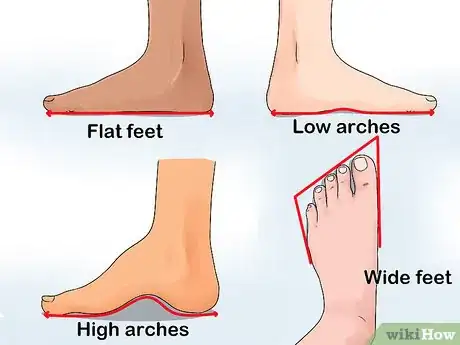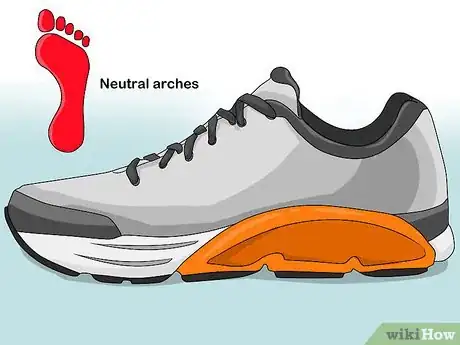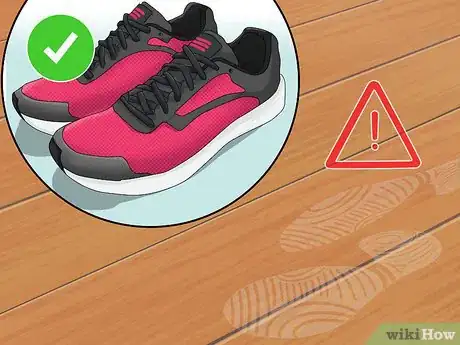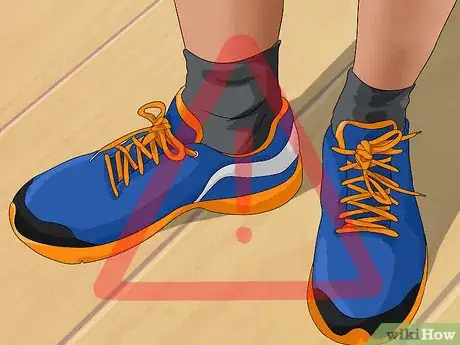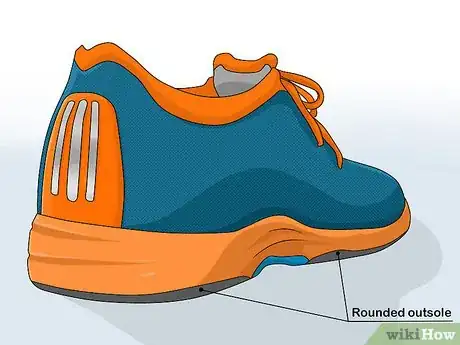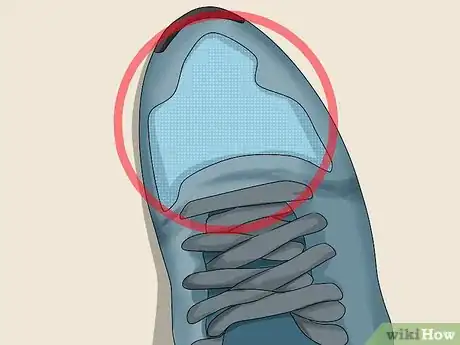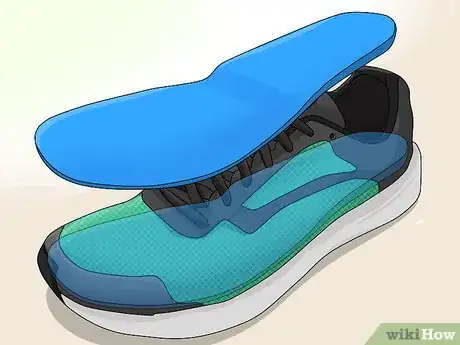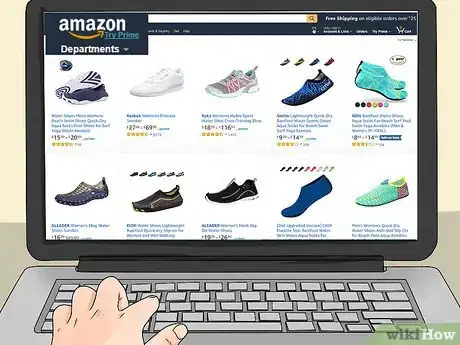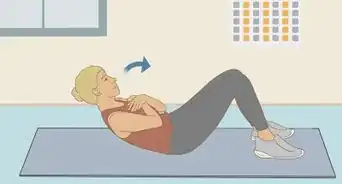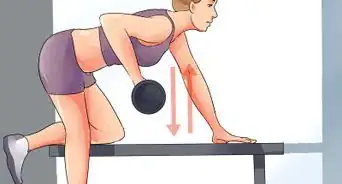This article was co-authored by Michele Dolan and by wikiHow staff writer, Sophia Latorre. Michele Dolan is a BCRPA certified Personal Trainer in British Columbia. She has been a personal trainer and fitness instructor since 2002.
This article has been viewed 90,541 times.
Step aerobics is a high-intensity and low-impact cardiovascular exercise. It’s essential to wear proper shoes during aerobic exercise to provide support and prevent injury. Not all athletic shoes are equal to the task of supporting your movement, so do not attempt step aerobics in street or running shoes. Determine your footwear needs by identifying if you have foot problems or variations. Then, choose shoes specially designed for aerobics that fit correctly and have non-marking soles.
Steps
Determining Your Footwear Needs
-
1Identify if you have foot problems or variations. Many people have variations such as flat feet, high arches, low arches, or wide feet. If this applies to you, you’ll need to choose shoes designed for your problem or variation. To find out if you have foot problems or variations, wet your foot and make a print on a brown piece of paper. Then, trace the outline of your foot.[1]
- If your footprint shows the entire sole of your foot, with little to no curve on the inside, you have low arches or flat feet.
- If your footprint shows only a portion of your forefoot and heel, with a narrow connection between the two, you have high arches.
- If your footprint has a distinct curve along the inside, you have a neutral arch.
-
2Choose a shoe with a maximum support for flat feet. Flat feet leads to overpronation, meaning your feet roll inward. This creates extra wear on the inside heel and inside forefoot, so you’ll want a shoe with a motion-control feature.[2]Advertisement
-
3Choose a shoe with a soft midsole and extra cushioning for high arches. High arches lead to underpronation, meaning your feet roll outward. This creates extra wear on the outer edge of the heel and little toe.[3]
-
4Choose a “stability” shoe for neutral arches. If you have neutral arches, you’ll need a shoe the right amount of support and cushioning, so choose one with a stability feature.[4]
Choosing Aerobics-Specific Details
-
1Take into account the type of flooring you use for aerobics. If you do step aerobics on wood or linoleum, you need soles with very good traction. If you do your aerobics on carpet, you want a lower amount of tread so the shoe doesn't catch on the carpet pile.
-
2Choose aerobics shoes with non-marking rubber soles. This is especially important if you workout at a gym. Most gyms have hardwood or linoleum flooring, and shoes with marking black soles leave streaks on the floor, so you may be asked not to use them.[5]
-
3Avoid wearing running or walking shoes for aerobics. These are popular shoes, but they are made for straight movement and provide no lateral support, so your ankles are prone to injury. If you are unsure of whether a shoe you are looking at is for running, ask a store employee or look on the manufacturer's website.[6]
Shopping for Aerobic Shoes
-
1Go to a specialty sport-shoe store to try on aerobic shoes. Choose a specialty sport-shoe store with a large inventory and a knowledgeable sales staff. Do an Internet search to find such a store in your area.[7]
- If you choose to shop for aerobics shoes exclusively online, go to a site that has free shipping, such as Amazon's Endless website. Choose a few pairs of shoes using the above criteria. You may want to order several pairs then try them on when they arrive and send back the ones you don’t need.
-
2Pick the right size. It’s a good idea to have a sales associate measure your feet in the store. This will ensure you are buying the correct size of aerobic shoes. There should be about ⅜ to ½ inch (0.95 to 1.27 cm), or about a thumb’s width, between the front of your big toes and the end of the shoe.[8]
- The heel should be relatively tight, and shouldn’t slip out when you walk.
- The upper part of the shoe (which goes over the top of your foot) should feel snug and secure, but not too tight.
-
3Select lightweight shoes. For aerobics, you’ll want a lightweight shoe to prevent foot fatigue. Look at the materials the shoes are made out of, and hold several pairs of aerobic shoes in your hands, one at a time, to determine which are light and which are heavy.[9]
-
4Test the flexibility of the shoes. Place one hand at the heel and the other hand at the toe of the shoe and twist. In good aerobics shoes, the front section of the shoe should twist with a small amount of resistance.
-
5Choose a shape with a wide, rounded outsole. You may have seen shoes with heels that seem to go out much further than your foot bed. A round outsole in front gives you extra stability during lateral, side-to-side movement, while a wide heel gives extra cushioning as you step down.
- Look for a firm heel counter. A heel counter is material that is put around the heel to stiffen it and give extra support to the rest of the foot bed.
-
6Examine the shoe's upper. The upper is the area that covers the top of the foot. If your feet tend to get extra sweaty or smelly, look for a material that is sturdy, but breathable. Firm leather provides the best outer foot support; however, they can be more expensive, heavier, and less breathable than synthetic materials.
-
7Pick shoes with cushioned insoles. Aerobics shoes should have insoles (the inside part your foot rests on) with enhanced cushioning. Although aerobics are low impact, you’ll want a shoe with extra shock absorption under the ball of your foot.[10]
- Press on the insole with your thumb. The softer it is, the more likely it is to give you cushioning and shock absorption.
- A shoe with an insole made from ethylene vinyl acetate (EVA) is a good option. Gray EVA is firmer, while white EVA is softer and is best for aerobic exercise.[11]
-
8Try on several pairs of shoes before purchasing. It’s important to try on multiple pairs of shoes before deciding which ones to take home. Choose the shoe that is the most comfortable to you from the get-go. There should not be a “break-in” period.[12]
- Try on aerobics shoes with athletic socks. You want to make sure they fit well with the thickness of the socks you will regularly use.
-
9Test out your shoes on a similar floor to the one you exercise on. Go to an area of the store that has similar flooring to your step aerobic environment and do some aerobic moves. Move laterally, jump, and walk around in each pair of potential shoes. See which have the best grip and the most support for your feet.
-
10Read reviews of a shoe before you buy it. Go to Amazon or Zappos and cull the reviews to look for people who use them for step aerobics. This will give you a better idea of the support and durability of the shoe.
Expert Q&A
-
QuestionCan you wear running shoes to train?
 Michele DolanMichele Dolan is a BCRPA certified Personal Trainer in British Columbia. She has been a personal trainer and fitness instructor since 2002.
Michele DolanMichele Dolan is a BCRPA certified Personal Trainer in British Columbia. She has been a personal trainer and fitness instructor since 2002.
Certified Fitness Trainer Yes, running shoes are fine for training, but you may find agility is hindered by the usually wider base of a runner. Cross trainers and tennis shoes have generally smaller bases.
Yes, running shoes are fine for training, but you may find agility is hindered by the usually wider base of a runner. Cross trainers and tennis shoes have generally smaller bases. -
QuestionWhat type of shoes is good for Zumba?
 Michele DolanMichele Dolan is a BCRPA certified Personal Trainer in British Columbia. She has been a personal trainer and fitness instructor since 2002.
Michele DolanMichele Dolan is a BCRPA certified Personal Trainer in British Columbia. She has been a personal trainer and fitness instructor since 2002.
Certified Fitness Trainer Cross trainers are good for Zumba, but it's good to try several brands and features to determine the best type for your feet.
Cross trainers are good for Zumba, but it's good to try several brands and features to determine the best type for your feet. -
QuestionHow should workout shoes fit?
 Michele DolanMichele Dolan is a BCRPA certified Personal Trainer in British Columbia. She has been a personal trainer and fitness instructor since 2002.
Michele DolanMichele Dolan is a BCRPA certified Personal Trainer in British Columbia. She has been a personal trainer and fitness instructor since 2002.
Certified Fitness Trainer Workout shoes should cup your heel, support your arches and provide enough room for your toes so they don't touch the end of the shoe or feel squished.
Workout shoes should cup your heel, support your arches and provide enough room for your toes so they don't touch the end of the shoe or feel squished.
References
- ↑ http://www.webmd.com/fitness-exercise/features/how-choose-athletic-shoes#1
- ↑ http://www.webmd.com/fitness-exercise/features/how-choose-athletic-shoes#1
- ↑ http://www.webmd.com/fitness-exercise/features/how-choose-athletic-shoes#1
- ↑ http://www.webmd.com/fitness-exercise/features/how-choose-athletic-shoes#1
- ↑ http://www.today.com/money/spring-your-step-best-exercise-shoes-wbna24159168#.TpesGZzrXgg
- ↑ http://www.aofas.org/footcaremd/how-to/footwear/Pages/Selecting-Athletic-Shoes.aspx
- ↑ https://www.bodybreak.com/be-active/aerobic-guide/aerobic-guide-choosing-proper-exercise-shoes/
- ↑ http://www.webmd.com/fitness-exercise/features/how-choose-athletic-shoes#2
- ↑ http://www.aofas.org/footcaremd/how-to/footwear/Pages/Selecting-Athletic-Shoes.aspx
- ↑ http://www.aofas.org/footcaremd/how-to/footwear/Pages/Selecting-Athletic-Shoes.aspx
- ↑ http://www.podiatrytoday.com/blogged/understanding-impact-shoe-insoles-and-midsoles
- ↑ https://www.bodybreak.com/be-active/aerobic-guide/aerobic-guide-choosing-proper-exercise-shoes/
- ↑ https://www.bodybreak.com/be-active/aerobic-guide/aerobic-guide-choosing-proper-exercise-shoes/
